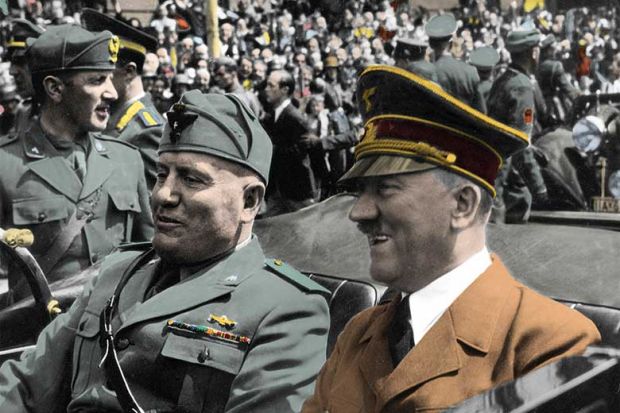When Adolf Hitler’s armies occupied Czechoslovakia in March 1939, his fascist partner in crime, fellow imperialist and dictator-next-door Benito Mussolini complained that “Every time Hitler occupies a state he sends me a message.” The point was clear enough – Hitler had not consulted Mussolini as an equal beforehand, but had merely told him after the event – and the significance was similarly obvious. By this point at the latest, the elder statesman of Europe’s dictators was very much the junior partner, condemned to acquiesce in German diplomatic, and later military, moves that would eventually lead both to disaster.
Worse was to come. Italy’s failure to enter the war in 1939, and the poor performance of its armies in 1940 and 1941, confirmed most Germans’ deepest prejudices concerning Italian reliability and military prowess. These views ran deep in German society on account of the experiences of the First World War. The fascist regime was plunged into crisis by successive defeats and wartime deprivations. When Mussolini was removed by the Italian king in 1943, the humiliation was complete, and the revenge visited by the Germans on ordinary Italians brutal.
Yet it had not always been so. There had been a time when Mussolini was an established European leader and Hitler a figure on the margins who wrote in vain asking the former for a signed photograph. In 1934, Mussolini’s movement of troops to the Brenner Pass in response to the Austrian Nazis’ assassination of chancellor Engelbert Dollfuss underlined Hitler’s early diplomatic isolation and showed who of the two dictators was boss.
In this very readable book, Christian Goeschel traces the changing dynamics of the relationship between the two, focusing on cultural diplomacy as a means to explore shifts of power and authority over time. Who travelled to visit whom, who was received where, who wore what, who stood next to whom in the photographs and so on – all these were acts of communication to each other and to the world outside. To the casual observer, they signalled the immutability of the fascist alliance. To the more attentive onlooker, Goeschel shows, they provide a more textured insight, legible in correspondingly subtle ways, into the stresses, strains and divisions that accompanied the relationship throughout.
They also provided insights into the differences between the two regimes. Nazi Germany, more firmly in control of the traditional apparatus of state than Mussolini was ever to be, developed its own brand of cultural diplomacy, comparatively – if not entirely – free of the restraints of inherited protocol. In Italy, meanwhile, the presence of the monarchy meant that conventional protocol was retained to a greater extent, causing occasional embarrassment to a German dictator who was sometimes not sure how to behave.
At the height of their powers, both were able to put on a public show that made clear that this was no ordinary alliance. Yet, apart from a relatively brief moment in the late 1930s when Italian and German cultural diplomacy adopted full-on fascist style, one is struck by the familiarity of the issues that Goeschel describes. The choreography of EU summits, for example, shows many similar characteristics. Watch out for those group pictures with Theresa May hopelessly marginalised, and the point is obvious enough.
Neil Gregor is professor of modern European history at the University of Southampton.
Mussolini and Hitler: The Forging of the Fascist Alliance
By Christian Goeschel
Yale University Press, 400pp, £20.00
ISBN 9780300178838
Published 14 August 2018
POSTSCRIPT:
Print headline: Doomed union of two dictators
Register to continue
Why register?
- Registration is free and only takes a moment
- Once registered, you can read 3 articles a month
- Sign up for our newsletter
Subscribe
Or subscribe for unlimited access to:
- Unlimited access to news, views, insights & reviews
- Digital editions
- Digital access to THE’s university and college rankings analysis
Already registered or a current subscriber?









